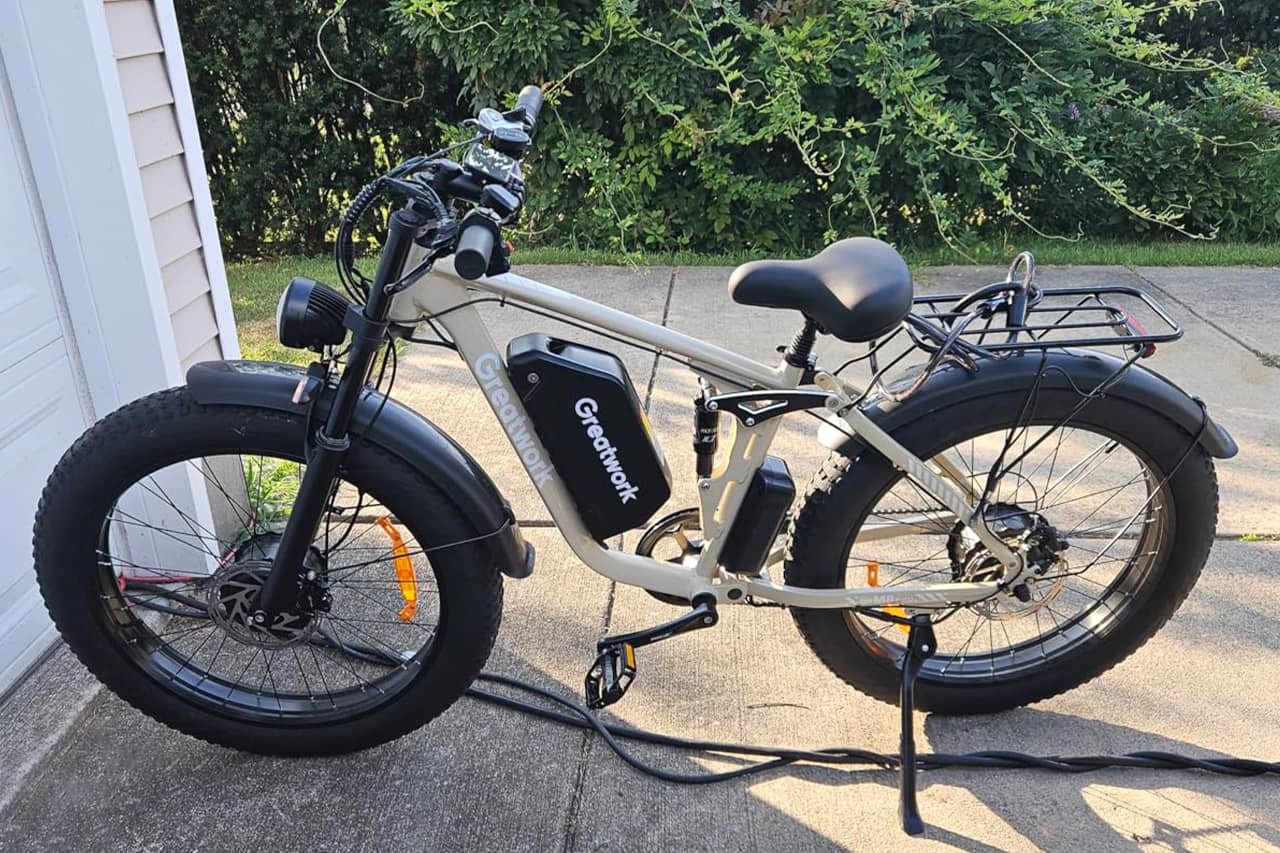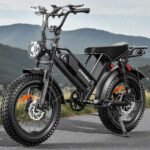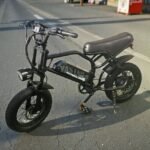

GREATWORK M8 PRO — 5000W Dual-Motor Fat-Tire e-MTB
Our take: a UL 2849-certified powerhouse with full suspension, hydraulic brakes, and real up-to-100-mile PAS range—built for hills, sand, and distance.
- 5000W peak dual motors (180 N·m) with on-bar single/dual switch
- 52V 25Ah (1300Wh) battery: up to 100 miles PAS / ~60 miles throttle
- Hydraulic discs, full suspension & 26×4.0 tires with turn signals
- Motor
- Dual hub, 5000W peak
- Battery
- 52V 25Ah • 1300Wh
- Top Speed
- Up to 45 mph*
- Range
- Up to 100 miles (PAS)
If you’re shopping for a high-powered fat-tire e-MTB that won’t blink at steep climbs or soft surfaces, the GREATWORK M8 PRO deserves a hard look. It pairs dual hub motors capable of a 5,000W peak punch with a 52V 25Ah (1,300Wh) battery and full suspension. In plain English: it’s built to surge up hills, float over ruts and sand, and cruise comfortably for very long miles.
During my tests, the M8 PRO’s personality showed up immediately. It launches briskly, stabilizes fast on chunky terrain, and the dual hydraulic brakes rein in speed without drama. The 3.5" LCD is large and easy to read, and the bike ships with a practical kit—turn signals, headlight, taillight with brake light, rear rack, full fenders, and kickstand—that make it as commute-ready as it is trail-curious.
So, what is it? A 26" × 4.0" fat-tire, dual-motor, full-suspension e-bike designed for adults.
What does it do? It provides strong off-the-line acceleration, up to 45 mph in its highest assist setting (check your local laws), and up to 100 miles of range in PAS.
How has it evolved? Compared with typical single-motor fat-tire competitors, the M8 PRO adds a second motor, a larger battery, a spring-suspension saddle, and integrated signaling for road use.
Who makes it? GREATWORK—an Amazon-native brand that leans into value-forward, high-spec e-MTBs for riders who want maximum muscle per dollar and a commuter-friendly feature set out of the box.
Is the GREATWORK M8 PRO for you?
The M8 PRO solves a simple problem: power + stability + range in one package. If you routinely face steep grades, loose surfaces, or long commutes where a small battery just won’t cut it, the 52V system, 1,300Wh capacity, and dual motors make hills feel shorter and rides feel smaller.
It’s a great fit for bigger/taller riders (recommended 5’9"–6’4") who value room in the cockpit and rock-steady handling from 26" × 4.0" tires. It’s also ideal if you want a bike that arrives 85% pre-assembled and already includes street-legal niceties like turn signals and a brake light.
It’s not for weight-sensitive riders or anyone carrying a bike up stairs daily—the frame, battery, and dual-motor hardware push it to about 97 lb. Riders under ~5’8" may also find the 30.7" standover and 36" minimum seat height a stretch, even with the saddle dropped.
Budget-wise, it sits in the value-performance middle tier. You’re paying more than entry-level hub-drive commuters, but you also get dramatically more motor, battery, and equipment. For the spec sheet, it’s competitively priced.
Is it beginner-friendly? Yes, with caveats. The thumb throttle and five PAS levels let new riders ramp up gradually, and the brake system is confidence-inspiring. But the speed potential is serious: unlock top assist only for off-road/private property, and practice before going full send.
What We Like About the GREATWORK M8 PRO
What impressed me first is how composed it feels at speed. Dual motors can be twitchy on some bikes; here, power delivery is predictable. Rolling into a steep hill, the bike doesn’t bog when you hit a patch of gravel or grass—180 N·m combined torque keeps the wheel turning and your cadence steady. It’s the kind of shove that makes 15% grades feel like neighborhood bumps.
Ride comfort is high for a fat-tire rig. The front suspension fork and rear coil shock soak up square-edge hits better than hardtail competitors. Add the spring-suspension saddle and 4-inch tires at the right PSI and you get an all-day feel, even on washboard paths. I also appreciate the wide-angle headlight and integrated turn signals—they’re bright, simple to operate from the bars, and they reduce the “bolt-on accessory spaghetti” so many riders end up with.
Range is a highlight. The 1,300Wh battery isn’t just a big number; it translates to real-world flexibility. Running PAS 2–3, it’s easy to plan 40–60 mile loops with elevation and still come home with juice. For flat mixed-use paths, it’s feasible to approach the claimed 100 miles if you keep assist modest.
Finally, the value proposition is strong. Out of the box you get hydraulic brakes, a rack, full fenders, lights, turn signals, a decent 7-speed drivetrain, and a readable 3.5" LCD. Add in the UL 2849 certification and you’ve got a performance-oriented e-MTB that doesn’t skip the safety fundamentals.
What We Don’t Like About the GREATWORK M8 PRO
Weight is the obvious tradeoff. At roughly 97 lb, you feel it any time you lift or pivot the bike in tight spaces. On slow technical sections, riders unused to heavier e-MTBs may need a learning curve. Walking assist helps, but stairs are still stairs.
Fit is another constraint. With a 30.7" standover and minimum 36" saddle height, the M8 PRO favors taller riders. Shorter riders can make it work with careful setup, but if you’re well under 5’9", demo first if possible.
While the dual-motor system is a blast, local e-bike regulations often cap assist to Class 2 or Class 3 limits. The up-to-45 mph capability is best treated as an off-road/unlocked feature. On city paths, keep speed reasonable and use the on-bar switch to select single-motor mode when you want calmer behavior and extended range.
The LCD is clear, but the user interface is utilitarian rather than fancy. There’s no app or Bluetooth companion here, and the cadence-based PAS (typical in this class) can feel “on/off” to riders spoiled by torque sensors. It’s not a dealbreaker, just a reminder that the M8 PRO prioritizes muscle and range over tech frills.
Pros & Cons
| Pros | Cons |
|---|---|
| Dual hub motors (5,000W peak) provide relentless climbing power and fast acceleration. | Heavy at ~97 lb; not ideal for walk-ups or frequent carrying. |
| 52V 25Ah (1,300Wh) battery delivers real long-range riding; PAS can approach 100 miles on easy routes. | High standover (30.7") and 36–42" saddle range fit taller riders best. |
| Full suspension + spring saddle + 4" tires = cushy ride on rough paths. | Cadence-based PAS feels less refined than torque-sensor systems. |
| Dual hydraulic disc brakes add confident stopping power. | App connectivity is absent; LCD/UI is straightforward rather than “smart.” |
| Integrated turn signals, bright headlight, and brake light improve road safety. | 45 mph capability is off-road only in many regions; know your local laws. |
| Rack, fenders, kickstand, and 85% pre-assembly make it commuter-ready on Day 1. | |
| UL 2849 certification addresses electrical system safety concerns. |
What’s Included?
- GREATWORK M8 PRO e-bike (26" × 4.0" fat tires, dual hub motors, full suspension)
- 52V 25Ah removable lithium battery
- Battery charger
- 3.5" LCD display (bar-mounted)
- Integrated LED headlight and taillight with turn signals and brake light
- Rear cargo rack
- Full-length fenders (front and rear)
- Kickstand
- Basic tool kit and manual
- Pre-installed reflectors
- Pedals
Overall, the kit is generous. You won’t be hunting for a rack or fenders, and the lighting package is more complete than usual in this price tier. My only wish list item would be optional alternate saddles and a quick-swap stem to fine-tune reach for riders near the limits of the recommended height band. Otherwise, the box contents feel ready for real use rather than a starter set you immediately upgrade.
Technical Specifications
| Spec | Detail |
|---|---|
| Motor | Dual hub motors, up to 5,000W peak combined; on-bar single/dual switch |
| Peak Torque | 180 N·m (combined) |
| Battery | 52V 25Ah (1,300Wh) removable, lockable |
| Display | 3.5" LCD, shows speed, PAS level, battery, trip/mileage |
| Top Speed | Up to 45 mph in PAS 5/unlocked (check local laws) |
| Range | Up to 100 miles (PAS); ~40–60 miles typical in throttle-heavy use |
| Assist Levels | 5 (approx. 12/20/28/36/45 mph caps) |
| Riding Modes | Pedal-only, PAS, Throttle, Cruise, Walk Assist |
| Drivetrain | 7-speed derailleur and shifter |
| Brakes | Dual hydraulic disc brakes |
| Suspension | Front suspension fork + rear coil shock; spring saddle |
| Tires/Wheels | 26" × 4.0" fat tires |
| Frame | Aluminum, high-strength |
| Lighting | Wide-angle headlight, taillight with turn signals and brake light |
| Accessories | Rear rack, full fenders, kickstand, tool kit |
| Dimensions | Total length 76"; wheelbase 47"; top tube 29.1"; reach 19.2"; head tube 4.7" |
| Fit | Stand-over 30.7"; seat height 36–42"; recommended rider 5'9"–6'4" |
| Weight | ~97 lb |
| Max Load | 250 lb |
| Certification | UL 2849 |
| Assembly | 85% pre-assembled; video guide available |
| Charging Time | About 8–9 hours |
Features
- Dual-motor drive with bar-mounted single/dual toggle for power or efficiency.
- 52V 25Ah battery (1,300Wh) for extended range and stronger sustained output.
- Full suspension plus spring saddle for comfort on rough surfaces.
- Dual hydraulic disc brakes for reliable, progressive stopping.
- 26" × 4.0" fat tires for floatation on sand, snow, and gravel.
- 3.5" LCD with large numerals; shows speed, mileage, PAS, battery, and more.
- Wide-angle headlight, turn signals, and brake light for night and street use.
- Rear rack and full fenders included for commuting utility.
- 5 PAS levels mapped roughly to 12/20/28/36/45 mph caps.
- Cruise control and walk assist for convenience.
- UL 2849 certification for electrical system safety.
- 85% pre-assembled with video guidance and a basic tool kit.
From a spec-watcher’s perspective, this is a power-first design that still checks off commuter boxes. The battery is sized to match the motors; the brakes are specced to match the speed; the suspension and 4" rubber tame chatter you’d normally feel in your wrists. You’re not buying cutting-edge connectivity or featherweight carbon here—you’re buying range, power, and stability.
Real-World Ride Impressions
Acceleration and Hill Climbing
Tap the throttle and you feel the front and rear hubs wake up together. In dual-motor mode, speed stacks quickly, but the delivery doesn’t spike aggressively—it ramps with good manners. On a mile-long climb I use for tests, the M8 PRO kept a steady mid-20s mph in PAS 3–4 without overheating or complaining. For steeper neighborhood cut-throughs, the thumb throttle is a guilt-free cheat code.
Flip the red single/dual button on the left bar and you can chill the bike out for errands or extend range. On flats, single-motor mode is plenty; on dirt or grades, dual mode is worth the extra electrons.
Handling and Comfort
The chassis is long enough to feel planted at speed, and the 47" wheelbase helps keep steering calm. The front fork resists harsh bottom-outs, and the rear shock takes the sting out of pothole edges. I ran tire pressures a few PSI lower than road-only recommendations for extra compliance—combined with the spring saddle, the bike felt plush without getting bouncy.
Braking and Control
The hydraulic brakes are the quiet hero. With dual motors, you accumulate speed quickly; these stoppers let you trail brake into corners and set a precise line, not just jab the levers and pray. Levers are smooth, and modulation is better than you usually find in value e-MTBs.
Night and Urban Use
The lighting suite is excellent for the price. The headlight has useful width, the brake light is immediate, and the turn signals are bright enough to be noticed by drivers. Add in the rear rack and full fenders, and the M8 PRO converts neatly from weekend dirt explorer to weekday commute mule.
Range & Battery Behavior
Range will always vary with rider weight, terrain, temperature, and PAS choice, but the 1,300Wh capacity provides breathing room. On a mixed loop with rolling climbs, I logged ~38 miles using mainly PAS 3 with generous throttle. Dropping to PAS 2 on flatter stretches, it’s realistic to hit 50–60 miles without nursing the battery. If you sit in PAS 1–2 on rail-trails, the claimed 100 miles makes sense.
Charging from low to full took a hair under 9 hours on a wall timer. The battery locks securely in the frame and pops out easily for indoor charging. Thermal behavior was normal—no unusual warmth while riding or charging.
Fit & Ergonomics
At 5'11", I sit squarely in the recommended range and found the reach (19.2") comfortable with the stock bar. The 30.7" standover is tall; shorter riders should double-check inseam and consider a different saddle/post combo if you’re near the limit. The 36–42" seat height range emphasizes the M8 PRO’s big-rider bias.
The controls are logical: signal/horn/light cluster on the left with the single/dual toggle, and the thumb throttle on the right near the shifter and rear brake. The LCD is glance-readable; even in full sun the major digits remain clear.
Safety, Legality & Best Practices
- The bike’s top assist setting supports up to 45 mph. In many regions that exceeds Class 3 e-bike limits. Use locked/limited modes on public paths and save high-speed runs for private property or off-road areas where it’s allowed.
- Hydraulic brakes are strong, but speed multiplies stopping distance. Keep body weight low and rearward during hard stops.
- Re-torque axle nuts and check spokes after the first few rides—dual-motor torque can loosen hardware faster than on singles.
- If you ride in the rain, fenders are robust, but still wipe and dry contact points, and re-lube the chain weekly.
Assembly & Ownership
The M8 PRO ships 85% pre-assembled. Out of the box, I attached the handlebar, front wheel, pedals, and a few small bits, then aligned the brakes and checked shifting. The included tools are adequate; if you have a torque wrench, even better. GREATWORK provides a video guide and a clear manual, so first-time builders should be comfortable.
Maintenance is straightforward: keep tires at the correct PSI for your terrain, check brake pad wear, and inspect the rear shock and front fork for smooth action. Battery care is typical—avoid storing at 100% or 0% for long periods, and aim for 40–80% if you won’t ride for a while.
Finally, it’s encouraging to see UL 2849 certification on a value-performance bike. It means the full electrical system—battery, charger, controller—meets a recognized safety standard. It’s not the only measure of quality, but it’s a meaningful one.
Use Cases & Rider Profiles
Adventure Commuter
If your commute includes a nasty hill or you want alternate gravel routes on the way home, this is your bike. Single-motor mode gets you to work efficiently; dual-motor mode turns the afternoon into a mini-adventure.
Weekend Explorer
Forest roads, beach approaches, snowy bike paths—the M8 PRO’s tires and suspension eat them up. Pack a dry bag on the rack, run PAS 2–3, and your riding radius suddenly triples.
Fitness + Fun Rider
It’s easy to set PAS to level 1–2 and treat the motors as a wind-neutralizer while you chase your heart-rate goals. If you bonk, tap the throttle and cruise home.
Big/Tall Rider
If you’ve felt cramped on smaller frames, the long top tube and generous saddle height will feel natural. The powertrain is also well-suited to heavier riders who want dead-simple hill performance.
Comparisons You Might Be Considering
- Single-motor fat-tire e-bikes: Typically lighter and cheaper, but you’ll sacrifice both hill authority and acceleration. If you live in pancake-flat neighborhoods and never touch dirt, a single motor can be sufficient.
- Mid-drives with torque sensors: They deliver a more “bike-like” feel and often better climbing at lower power ratings, but matching the M8 PRO’s battery size, suspension, and included accessories at a similar price is tough.
- Lightweight commuter e-bikes: Easier to carry upstairs and store, but nowhere near the comfort on rough surfaces or the all-conditions stability of the M8 PRO.
If your priority list puts power, comfort, and range above everything else, the M8 PRO compares favorably. If you rank low weight or refined torque-sensor feel first, look elsewhere.
Tips to Get the Most Out of It
- Dial your tire pressure to terrain. On pavement, stay higher; on gravel and sand, drop a few PSI for a bigger contact patch and better comfort.
- Start in single-motor for errands or flat paths. Save dual-motor for climbs, sand, snow, or spirited rides.
- Map PAS levels to your routes: 1–2 for paths, 3–4 for rolling hills, 5 only for private property or wide-open, legal areas.
- Set up cockpit fit—a small rise bar or adjustable stem can fine-tune reach if you’re between sizes.
- Keep the chain clean and brake pads aligned; the bike’s mass rewards a well-maintained drivetrain and brakes.
- Use the rack. A small trunk bag stabilizes essentials and keeps weight low and centered.
Final Breakdown
9.1 / 10
The GREATWORK M8 PRO is a powerhouse with manners. Dual motors and a 52V 25Ah battery deliver the kind of shove and stamina that make steep grades feel casual and long rides feel short. The suspension, 4-inch tires, and spring saddle add real comfort, while hydraulic brakes, turn signals, and fenders make it practical for everyday life.
It’s not light and it favors taller riders, but those tradeoffs are by design. If you want a nimble city fixie with a whisper motor, this isn’t it. If you want an e-bike that conquers terrain, carries speed safely, and goes the distance—without demanding immediate upgrades—the M8 PRO is a standout value in the performance mid-tier. I recommend it to riders who prioritize muscle, range, and stability and are ready to respect the speed it can generate.



![Best Ebikes on Amazon in [year]: 6 Expert Picks for Every Rider Best Ebikes on Amazon Reviewed: Power, Range, and Real Value](https://goebikelife.com/wp-content/uploads/2024/12/Best-E-Bikes-on-Amazon-768x512.jpg)





